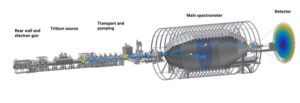Neutrinos are lighter than 0.8 electronvolts

Mounting of electrodes in the main spectrometer of the KATRIN experiment
Credit: Joachim Wolf/KIT
New world record: KATRIN experiment limits neutrino mass with unprecedented precision.
Neutrinos are arguably the most fascinating elementary particle in our universe. In cosmology they play an important role in the formation of large-scale structures, while in particle physics their tiny but non-zero mass sets them apart, pointing to new physics phenomena beyond our current theories. Without a measurement of the mass scale of neutrinos our understanding of the universe will remain incomplete.
This is the challenge the international KATRIN experiment at Karlsruhe Institute of Technology (KIT) with partners from six countries has taken up as the world´s most sensitive scale for neutrinos. It makes use of the beta decay of tritium, an unstable hydrogen isotope, to determine the mass of the neutrino via the energy distribution of electrons released in the decay process. This necessitates a major technological effort: the 70 meter long experiment houses the world´s most intense tritium source as well as a giant spectrometer to measure the energy of decay electrons with unprecedented precision.
The high quality of the data after starting scientific measurements in 2019 has continuously been improved over the last two years. “KATRIN is an experiment with the highest technological requirements and is now running like perfect clockwork” enthuses Guido Drexlin (KIT), the project leader and one of the two co-spokespersons of the experiment. Christian Weinheimer (University of Münster), the other co-spokesperson, adds that “the increase of the signal rate and the reduction of background rate were decisive for the new result”.
Data analysis
The in-depth analysis of this data was demanding everything from the international analysis team led by its two coordinators, Susanne Mertens (Max Planck Institute for Physics and TU Munich) and Magnus Schlösser (KIT). Each and every effect, no matter how small, had to be investigated in detail. “Only by this laborious and intricate method we were able to exclude a systematic bias of our result due to distorting processes. We are particularly proud of our analysis team which successfully took up this huge challenge with great commitment”, the two analysis coordinators are pleased to report.

The 70 meter long KATRIN experiment with its main components tritium source, main spectrometer and detector Leonard Köllenberger/KATRIN Collaboration
Credit: Leonard Köllenberger/KATRIN Collaboration
The experimental data from the first year of measurements and the modeling based on a vanishingly small neutrino mass match perfectly: from this, a new upper limit on the neutrino mass of 0.8 eV can be determined (Nature Physics, July 2021). This is the first time that a direct neutrino mass experiment has entered the cosmologically and particle-physically important sub-eV mass range, where the fundamental mass scale of neutrinos is suspected to be. “The particle physics community is excited that the 1-eV-barrier has been broken by KATRIN”, comments neutrino expert John Wilkerson (University of North Carolina, Chair of the Executive Board).
Susanne Mertens explains the path to the new record: “Our team at the MPP in Munich has developed a new analysis method for KATRIN that is specially optimized for the requirements of this high-precision measurement. This strategy has been successfully used for past and current results. My group is highly motivated: We will continue to meet the future challenges of KATRIN analysis with new creative ideas and meticulous accuracy.”
Further measurements should improve sensitivity
The co-spokespersons and analysis coordinators of KATRIN are very optimistic about the future: “Further measurements of the neutrino mass will continue until the end of 2024. To realise the full potential of this unique experiment, we will not only steadily increase the statistics of signal events, we are continuously developing and installing improvements to further lower the background rate.”
The development of a new detector system (TRISTAN) plays a specific role in this, allowing KATRIN from 2025 on to embark on a search for “sterile” neutrinos with masses in the kiloelectronvolt-range, a candidate for the mysterious dark matter in the cosmos that has already manifested itself in many astrophysical and cosmological observations, but whose particle-physical nature is still unknown.
Journal: Nature Physics
DOI: 10.1038/s41567-021-01463-1
Method of Research: Experimental study
Subject of Research: Not applicable
Article Title: Direct neutrino-mass measurement with sub-eV sensitivity
Article Publication Date: 14-Feb-2022
All latest news from the category: Physics and Astronomy
This area deals with the fundamental laws and building blocks of nature and how they interact, the properties and the behavior of matter, and research into space and time and their structures.
innovations-report provides in-depth reports and articles on subjects such as astrophysics, laser technologies, nuclear, quantum, particle and solid-state physics, nanotechnologies, planetary research and findings (Mars, Venus) and developments related to the Hubble Telescope.
Newest articles

Innovative 3D printed scaffolds offer new hope for bone healing
Researchers at the Institute for Bioengineering of Catalonia have developed novel 3D printed PLA-CaP scaffolds that promote blood vessel formation, ensuring better healing and regeneration of bone tissue. Bone is…

The surprising role of gut infection in Alzheimer’s disease
ASU- and Banner Alzheimer’s Institute-led study implicates link between a common virus and the disease, which travels from the gut to the brain and may be a target for antiviral…

Molecular gardening: New enzymes discovered for protein modification pruning
How deubiquitinases USP53 and USP54 cleave long polyubiquitin chains and how the former is linked to liver disease in children. Deubiquitinases (DUBs) are enzymes used by cells to trim protein…


